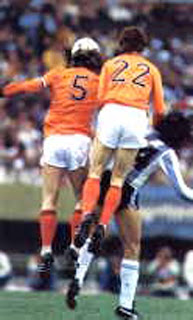The African Champions Cup was going steady too – it's 13th issue already. The participants were still relatively few, so the tournament really started with the 1/8 finals. The preliminary round was mostly on paper – 8 teams advanced by byes. Withdrawals were common and the tournament really was played in earnest after the 1/8 finals. At least on paper, it was more normal competition: away ties and wins did happen fairly often. By 1978 tradition existed too – the ½ finalists were quite familiar names, constantly strong and successful: Hafia (Conakry, Guinea), already the most successful African club, three times winner of ACC; AS Vita Club (Kinshasa, Congo, then Zaire), the 1973 winner; Canon (Yaounde, Cameroon), the winner in 1971; and the Nigerian champions Enugu Rangers, winner of African Cup Winners Cup in 1977. Little can be said about the quality of the game, but at least it was competitive: Canon and Enugu Rangers were unable not only overcoming each other, but to score a single goal – after two 0-0 ties, penalty shoot-out decided the finalist. Canon clinched 6-5 victory.
The other semi-final was decided by away goal. Hafia won at home 2-0, but lost 1-3 in Zaire. The goal they scored visiting AS Vita Club propelled to the final and to the chance of winning 4th Cup.
The two-leg final started on December 3 in Conakry and Hafia was unable to win – the match ended 0-0. On December 17 they faced mission impossible at unhospitable Omnisport stadium in Yaounde. Canon won 2-0 and the Cup – for a second time.
Canon (Yaounde) – winners of the African Champions Cup in 1978. Cameroonian football was strong in Africa, at least on club level. However, nothing could be said about the wining squad – not even their names. Except one:
Thomas N'Kono – or Nkono, depending on spelling and source – was keeping the ball out of Canon's net. Of course, he was entirely unknown yet and had to wait 4 more years to be 'discovered'.
The second African club tournament remained entirely in the dark. The Cup Winners Cup was still young tournament, established in 1975. Just like the first African Champions Cup, the first CWC was won by Cameroonian club – Oryx (Douala) won the ACC in 1965; Tonnerre (Yaounde) – the first CWC in 1975. After that two Nigerian clubs won it – Shooting Stars in 1976, and Enugu Rangers in 1977 – and now the 4th issue of the tournament was open to all. Fewer participants than those competing for ACC, but fewer withdrawals too – Sodiam (Banqui, Central African Republic) withdrew after the first leg was played against Al-Median (Lybia)in the preliminary round. The second round – or the 1/8 finals – went without troible, but a club withdrew in the ¼ finals – KMKM Zanzibar (Tanzania). Their Zambian opponents – Mufulira Wanderers – advanced.
The semi-finalists were clearly weaker than the corresponding semi-finalists in the Champions Cup: Kadiogo (Upper Volta – Burkina Faso today) paired with Horoya AC (Conakry, Guinea) and Mufulira Wanderers (Zambia) met MA Hussein-Dey (Algeria). On the strength of the successes of Hafia (Conakry) and general higher quality of football played in Northern Africa, the Guinean and the Algerian clubs were obvious favourites – on paper, at least. In reality the semi-finals went by the rules of African football... hosts win. Away goals decided the winners – Horoya AC lost the first leg 2-3, then won the home match 1-0. MA Hussein-Dey lost 1-2 in Zambia, won 1-0 at home. Were the matches really competitive, or were they fixed by the referees in favour of the host team nobody can tell. Only one thing is sure – the teams likelier to reach the final did so.
Two-leg final, the opening match played on November 24 in Algeria. The visitors won and comfortably too – 3-1 for Horoya AC. The second leg in Conakry on December 10 was not mere protocol: either Horoya saw themselves already winners, or the Algerians were determined to fight to the end, but whatever it was Horoya AC prevailed with difficulty – 2-1. At least, so much can be extracted by dry records – there is no information, not even a picture of the winners. Hack, there is not even a logo anywhere to be found... just the name: Horoya AC won the Cup Winners Cup in 1978, confirming the might of Guinean club football at the time, which curiously did not transform into strong national team.
As for the losing finalists, the information is a tiny bit more than for the winners:
The logo is right: MA Hussein-Dey eventually became NA Hussein-Dey, as it is known today. It is all-sports club, always having the name NA – MA was used for their football section. The abbreviation stands for Nasr Athlétique de Hussein Dey – a club founded in 1947 by the merger of three older clubs. Their 1978 players are unknown, but very likely a young guy played at the final:
Rabah Madjer. The photo is from later year – and from much more glorious forum than the African Cup Winners Cup. Madjer was only 20 years old in 1978 and unknown. Like Thomas N'Kono he was to become well known and to play in Europe. And to be remembered fondly for one fantastic goal – but all that was in the future, in 1978. Back then Madjer was a losing finalists, if he did play, and European fame was probably unimaginable.








.JPG)











.jpg)




.JPG)
.JPG)



.JPG)
.JPG)










.jpg)



.JPG)








